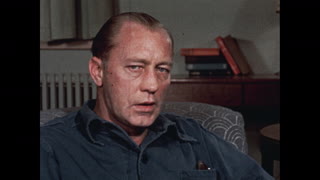This color educational film is about aphasic patients, mainly USA war veterans. It can occur suddenly after a stroke or head injury, or develop slowly from a growing brain tumor or disease. Aphasia affects a person’s ability to express and understand written and spoken language.Once the underlying cause is treated, the main treatment for aphasia is speech therapy. Copyright is circa 1950.
Opening titles: Testing And Individual Therapy For The Aphasic Patient (:07-:41). Four men sit in a room. They are all aphasic – they have a language disorder that affects their ability to communicate. A wounded veteran walks into an office and sits down, a woman works with him. A veteran uses tools. A wounded man walks out of a car with a cane. A veteran walks with a slight limp (:42-3:21). A wounded veteran explains what happened to him. Veterans eat food at a dinner table. A man with a bandage over his eye is met by a doctor. His reflexes are checked by the doctor. His feet are then touched (3:22-5:28). The man’s visuals are checked. An Asian veteran has his brain waves checked. A psychological evaluation for a veteran given by a female. She checks his speech patterns and then asks him a simple math question from a photo, he has trouble with it (5:29-7:29). The veteran is given a maze to try and get himself out of on a piece of paper. A female therapist speaks to the viewer about evaluating patients. A veteran is asked questions and answers them (7:30-9:13). A veteran is asked to do a projective test with pictures and placement. A veteran takes a test where he is to match colors with words (9:14-11:43). How the room should be so as to make it comfortable for the patient. A form – the 102526 form summarizes the test. Tests for motor aphasia, sensory aphasia, and formulation aphasia. Motor aphasia could include agraphia, an acquired neurological disorder causing a loss in the ability to communicate through writing, either due to some form of motor dysfunction or an inability to spell. Sensory aphasia and formulation aphasia are explained (11:44-13:44). A patient is relearning motor speech. A mirror is used to relearn tongue and lip positions. A female teaches the man how to say the word ‘man’ (13:45-15:51). The man continues to learn how to say ‘man.’ A female works with a veteran to learn how to write. He writes on a chalkboard (15:52-17:23). The female helps the man write on the chalkboard to relearn the pattern of writing. Sensory aphasia examples. A patient works with a female, she writes on a chalkboard. She then tries to get him to say a word (17:24-20:09). The man says the word. A man writes on a chalkboard and then asks the patient to read. He reads slowly and traces some words to help himself (20:10-22:25). A therapist sits with a veteran. The veteran is asked questions and answers some correctly. Some of the answers are played back on a reel to reel (22:26-24:29). A therapist plays back a patient’s words on a record, he listens intently. The therapist plays another record (24:30-26:10). Veterans sit and play cards together. Some of the veterans speak about their plans after they leave the hospital (26:11-27:18). End credits (27:19-27:28).


